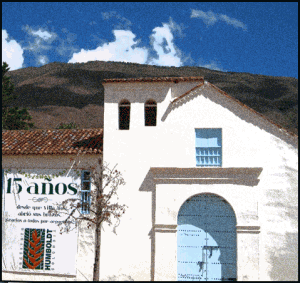 Dates: 8-11 October 2012.
Dates: 8-11 October 2012.
City: Villa de Leyva (Colombia).
Workshop venue: Claustro de San Agustín, Instituto Alexander von Humboldt. Dirección: Carrera 8 No. 15-08, Villa de Leyva (Boyacá), Colombia. Sitio web.
Organizers: SiB, Sistema de Información sobre Biodiversidad de Colombia (Instituto Alexander von Humboldt) and Spanish GBIF Node (GBIF.ES).
Language: Spanish.
Number of participants: 26.
Trainers/speakers: Cristina Villaverde (GBIF.ES), Danny Vélez (SiB Colombia), Greg Riccardi (The Florida State University), Francisco Pando (GBIF.ES), Juan Carlos Bello (SiB Colombia), Liliana Lara (CONABIO), María Cecilia Londoño (IAvH), María Fernanda Gómez (SiB Colombia), Maylin González (IAvH), Óscar Orrego (SiB Colombia).
Deadline for nominations: July 31st 2012.
Hotel: http://www.hotellaposadadesanantonio.com/
Contact information: Please contact the Spanish GBIF Node or the I3B Project (info [at] gbif es / i3b [at] gbif es) if you have any questions about this event.
Description and goals of the workshop
Why Biological Collections 3.0? [Introduction to the concept, comments are welcome]
The concept of this training course is to take advanced collection managers and curators from the region to the next frontier on collection management. After the paradigms of collections as card files and collections as isolated databases attached to physical specimens, now it is time to tackle aspects that will enable collections to be an integral part of a global information system on biodiversity for science and conservation. Current technologies and approaches will be dealt during the course.
Interoperability; images; semantic web and identifiers; annotations and connections to environmental and molecular databases – and the role of GBIF – are relevant in this context.
Emphasis will be made on how those data can be put at use, and how to do that in the best technical and sociological conditions; and to promote the train the trainer so all these advanced concepts and techniques can be adequately disseminated all over the region.
Target audience
This course is targeted to curators and collection managers leading biological collections topic, who are in a position to disseminate the workshop concepts in their work.
Call for nominations
Latin American GBIF Node managers and I3B members are kindly requested to nominate one or more suitable candidates no later than July the 31st. The nominations must be sent by email to i3b [at] gbif es and must include the registration form, the CV of the candidate, any relevant support letters and other relevant information.
The registration form can be downloaded here.
Due to space constraints, a selection process will be held shortly after this date, where the following criteria will be the main evaluation points:
-
Their potential involvement in the implementation of biological collections management activities within the GBIF or I3B network;
-
Background and knowledge on biodiversity and informatics of the candidates,
-
To be linked to collection management or collection conservation within the Latinamerican region.
Schedule
-
Publish the first mailing: 20th June 2012
-
Call for GBIF Nodes and I3B members: 27th June 2012
-
Deadline: July 31st 2012
-
Selection process: August 2nd-14th 2012
-
List of participants: August 15th 2012
 Dates: 8-11 October 2012.
Dates: 8-11 October 2012.